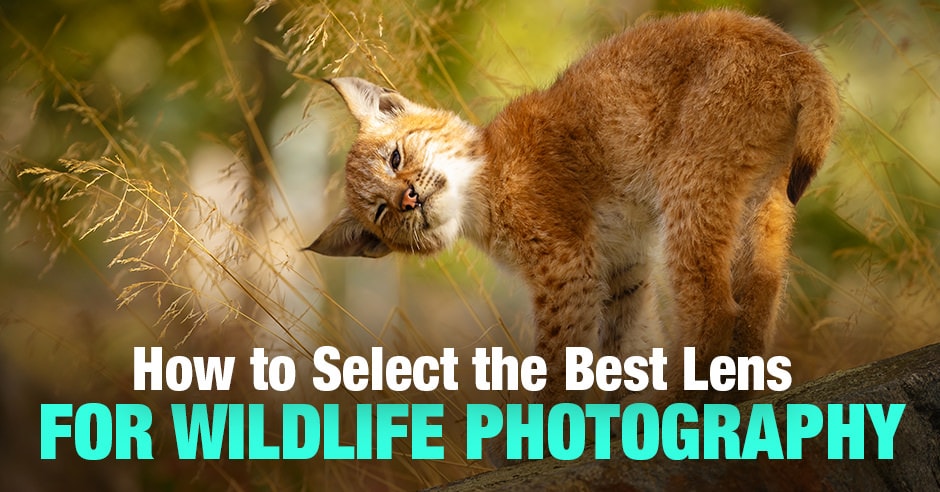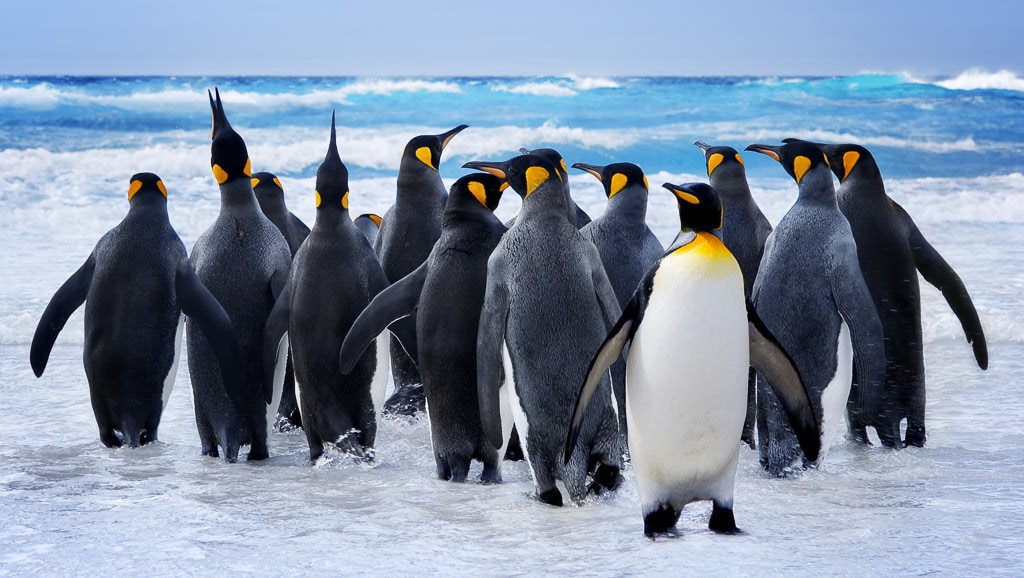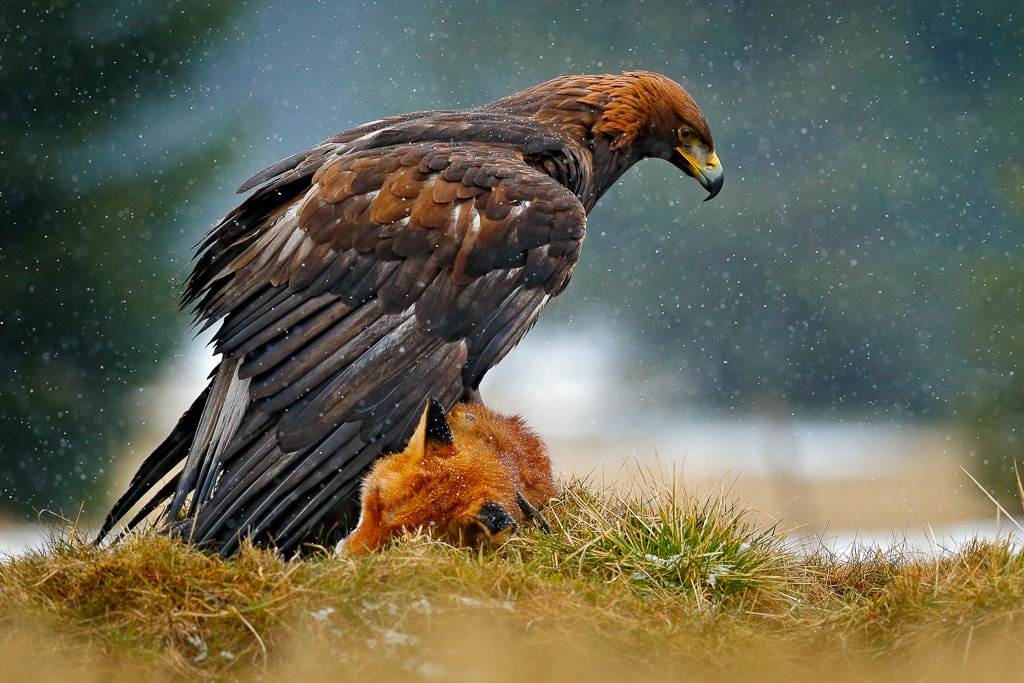Are you looking to pick the best lens for wildlife photography, but you aren’t sure what to purchase?
Don’t worry.
Because this article will give you everything
you need to know about wildlife photography lenses.
And you’ll ultimately come away knowing which
wildlife photography lens is best for you.

Quick Answer – Best Lens for Wildlife Photography
- Canon 100-400mm f/4.5-5.6 II
- Nikon 80-400mm f/4.5-5.6G VR
- Sony 100-400 f/4.5-5.6 OSS
- Fujinon 100-400mm F4.5-5.6 OIS
- Nikon 300mm f/4D
- Canon 400mm f/5.6L
- Tamron 150-600mm F/5-6
- Sigma 150-600mm f/5-6.3
- Tamron 100-400mm f/4.5-6.3
- Sigma 100-400mm f/5-6.3
- Canon EF 300mm f/2.8L IS II
- Nikon 300mm f/2.8G VR II
- Sony 300mm f/2.8
What to Look for When Selecting
the Best Lens for Wildlife Photography
When it comes to choosing a wildlife
photography lens, there are a few basic factors that you must take into
account:
Focal Length (Reach)
Wildlife photography always starts with focal length.
Because without a sufficiently long lens,
you’re going to end up with very few good shots and a lot of frustration.
The truth is that most lenses are too short for wildlife photography. Wildlife doesn’t stay still when you approach it, and it’s often not safe to approach it, anyway.
Which is why you’re going to need to shoot
animals from far back, using the power of a telephoto or super telephoto lens.
- Generally speaking, you’ll need a minimum of 300mm to capture frame-filling photos of large wildlife (e.g., bison).
- For smaller wildlife, 400mm is the minimum.
- And for birds, you’ll want the absolute longest lens you can afford – 400mm will get you close enough with very tame birds (think birds in very public areas and in your backyard), but 500mm or 600mm is better.
Also note that these recommendations are
assuming that you’re shooting with a crop-sensor camera. In other words, you
need a 300mm lens mounted onto a crop-sensor camera for a good shot at
photographing large wildlife.
And if you’re using a full-frame camera,
you’ll need something more like 500mm.

Zoom vs Prime
It’s time to ask yourself:
Do I want a prime lens or a zoom lens?
The tradeoff between these two lens types primarily comes in terms of flexibility. If you’re shooting a deer at 400mm and it ends up moving closer, you’re going to struggle if you’re working with a prime lens – but a zoom lens can back right up so you can keep shooting.
That said, you’ll often want more reach, not
less, so you’ll rarely be stuck in situations where you have too much focal
length.
And zoom lenses (especially quality zoom
lenses) can cost more than a good prime.
So here’s what I recommend:
If you plan on shooting wildlife in many different environments (including zoos, wildlife sanctuaries, other areas where the wildlife is acclimatized to humans), then go with a zoom lens. The flexibility will be important.
See also: Best Lens for Bird Photography
But if you’ll be in situations where maximum
reach is pretty much always of critical importance, then forgo the zoom and
stick with a high-quality prime. You’ll get more bang for your buck, and the
optics on primes are consistently incredible.

Maximum Aperture
Wildlife photography often takes place when the light isn’t ideal. In other words, you’re often dealing with low light as a wildlife photographer.
For this reason, the best maximum aperture for wildlife is f/2.8; this ensures you can keep your shutter speed fast enough to get sharp wildlife shots.
But lenses with higher maximum apertures can still work, especially if you have a camera that performs well in low-light scenarios. Not to mention that wide aperture lenses come with a depth of field compromise, when you often want to keep your subject sharp from front to back.
Weather Sealing
Wildlife photography tends to take place in
difficult conditions.
That’s where weather sealing comes in.
The best lenses offer at least some form of protection against the weather in the form of tighter seals and better build quality.
Related article: Weather Sealed Cameras – a Complete List
Can you dunk a weather-sealed lens underwater and remove it without issue? Almost certainly not, and I definitely wouldn’t try it. But weather sealing is good for situations where you’re shooting in light rain, light snow, a lot of dust, and more. It’ll keep you lens safe–which is why I recommend you prioritize lenses with weather sealing when picking the best wildlife photography lens.

Focus Speed and Accuracy
Wildlife is fast.
This means that, if you want to capture stunning action shots of wildlife, you need to use a fast-focusing, highly accurate lens.
See also:
You don’t have time to wait around while your
lens hunts for focus. By the time focus has been acquired, the wildlife will be
gone.
Make sense?
That’s why autofocus speed is critical.
And accuracy is key, too.
See also: Wildlife Photography Settings
So when choosing the best wildlife lens,
you’ll want to pick something that is known for its fast AF capabilities. At
the very least, you won’t want a lens that takes critical seconds to focus
while your subject moves away.
Native vs Third Party Lenses
One final factor to consider when purchasing a wildlife photography lens is whether you’d like to grab a native lens (e.g., Nikon, Canon, Sony), or a third-party lens (e.g., Tamron, Sigma).
See also: Best Camera for Nature Photography
These days, the main difference between third-party lenses and native lenses is price alone, because third-party manufacturers make some seriously high-quality glass.
That is:
You pay a premium for native lenses, because
they come with a popular brand label.
This is a fantastic opportunity for beginner wildlife photographers because third-party lenses offer comparatively equal optical quality, but for significantly less.
So I definitely recommend you consider third
party lenses. You don’t need to exclude native lenses from your search
entirely, but pay attention to the high-quality third-party options!
Best Wildlife Photography Lenses
Now let’s take a look at your different
wildlife lens options, starting with:
Best Value Lenses for Wildlife Photography
The lenses in this section offer the best
optics for the lowest price:
1. Canon 100-400mm f/4.5-5.6 II
The Canon 100-400mm f/4.5-5.6 II is the clear
choice for Canon wildlife shooters looking for a high-quality lens, and who
prize its combination of flexibility and optical quality.
The 100-400mm offers enough reach to satisfy
many wildlife photographers, especially with a crop-sensor camera body. And the
optics on the 100-400mm are incredible; the lens provides excellent sharpness,
even at 400mm.
This Canon super telephoto zoom is fairly pricey, but you get a lot for your money: speedy autofocus (for action shooting), image stabilization (for low light work), a great zoom range, and excellent optics.
2. Nikon 80-400mm f/4.5-5.6G VR
The Nikon 80-400mm is a fantastic all-around wildlife lens for Nikon shooters, which manages to incorporate a long zoom range, strong optical performance, and fast autofocus into a single semi-budget lens.
At 400mm, you should be able to capture images of larger wildlife and tame birds, especially if you’re shooting on a crop-sensor camera like the D500 or the D7500. And the Vibration Reduction will help you capture sharp shots in low light (as long as your subject isn’t on the move!).
It may not be quite as powerful as the Canon 100-400mm (above), but the 80-400mm is a formidable option.
3. Sony 100-400 f/4.5-5.6 OSS
The Sony 100-400mm f/4.5-5.6 is one of the pricier options on this list, but well worth it for the serious Sony wildlife photographer.
Like the lenses listed above, the focal length range brings a lot of flexibility with a nice long (400mm) end that’s enough to capture tame birds and wildlife, especially on an APS-C body.
You’ll also love the ultra-sharp optics, which give gorgeous images at the maximum aperture and at 400mm.
4. Fujinon 100-400mm F4.5-5.6 OIS
Fujifilm isn’t a company known for their super telephoto lenses, but–fortunately for Fujifilm shooters–they’ve managed to create a winner.
The 100-400mm f/4.5-5.6 is an excellent wildlife option, from its focal length flexibility to its impressive image sharpness (while the long end of the lens is less sharp than the rest of the range, it still promises strong photos). Autofocus speed is important for wildlife shooters who like to capture the action, and the Fujifilm 100-400mm doesn’t disappoint in that area, focusing quickly and efficiently.
Related article: The Reason I Switched from Sony for Fujifilm
As long as the 100-400mm is coupled with an excellent wildlife camera, you should have no problem keeping up with the action.
5. Nikon 300mm f/4D
The Nikon 300mm f/4D is hardly flashy compared to some of its more expensive competitors, but it manages to keep the price down while doing its job well.
The 300m f/4D is a prime lens, which means that it offers very little fiexibility, but does include stellar optics (the lens is extremely sharp, plus the f/4 maximum aperture is a nice bonus) and fast focusing. The main downside to this lens is the lack of Vibration Reduction and the overall weight of the lens; it’s not what I’d call a light choice.
But for the more budget-conscious photographer who wants to start out with professional quality glass, the Nikon 300mm f/4D is a good option.
6. Canon 400mm f/5.6L
The Canon 400mm f/5.6L is one of Canon’s older wildlife options–but it’s a great choice for anyone who wants to break into the 400mm space, but can’t drop 1500+ dollars on the 100-400mm zoom.
Sharpness is excellent, even wide open, and the focusing speed is impressive, certainly fast enough to track moving wildlife (if you have the tracking skills to go with it, of course!).
The chief downsides to this lens are its size/weight and lack of zoom. If you’re looking for an all-around, walkaround-type wildlife lens, the 400mm f/5.6L isn’t the way to go. But if you need great optics at 400mm above all else, then this is a lens I wholeheartedly recommend.
Best Budget Lenses for Wildlife Photography
In this section, you’ll find the budget zooms – lenses that give you a lot of reach for an impressively low price.
7. Tamron 150-600mm F/5-6
The Tamron 150-600mm is a monster zoom lens, giving you an amazing amount of reach on the long end–which is perfect for shooting even the smallest birds. It sports decent autofocus, though you may struggle to capture some of the fastest scenes (e.g., small birds in flight).
Long zooms lenses of this type generally have to sacrifice on something, and for the Tamron it’s optical quality in the 500-600mm range. While the lens performs well throughout many of its focal lengths, at 600mm you’ll notice a reduction in sharpness, plus some chromatic aberration.
Is this enough to disqualify the Tamron? Certainly not. The lens has a lot going for it, even if it isn’t perfect.
8. Sigma 150-600mm f/5-6.3
The Sigma 150-600mm manages to go toe-to-toe with its Tamron competitor (above), and manages to come out ahead–especially when it comes to optics.
If you’re a wildlife shooter, this lens includes the focal length you need. It also has the focusing speeds, managing to keep things fairly fast despite the impressively low price.
And while it’s not on the same level as most of the value lenses reviewed above, the Sigma 150-600mm really does deliver on sharpness, giving good results until it approaches 600mm, at which point things become a bit soft (but still usable).
9. Tamron 100-400mm f/4.5-6.3
At well under $1000, the Tamron 100-400mm is one of the cheapest super telephoto zooms out there–but performs so well you’d hardly know.
See also: Top Tutorials for Wildlife Photography
What can you expect from this lens?
First, an immensely useful focal length, allowing for serious wildlife shooting on the long end and captive animal photography on the shorter end.
As for the optics, while the Tamron 100-400mm isn’t stellar, it manages to hold its own, keeping things sharp in the middle of its zoom range and decent at the 400mm end. If you’re looking for an expensive, ultra-high performer, then I recommend you look elsewhere.
But if you’re looking for a combination of price and quality, the Tamron 100-400mm is certainly worth a try.
10. Sigma 100-400mm f/5-6.3
The Sigma 100-400mm is another budget super telephoto zoom, and one with a lot going for it: An unbelievably low price, an impressive focal length range, and great optics all rolled into one.
Add to that good build quality and Sigma’s Optical Stabilization technology, and you’ve got yourself a very solid wildlife option.
See also: Wildlife Photography Equipment for Beginners
The weakest aspect of the 100-400mm is its autofocus, which is decently fast but only fairly accurate. However, the lens really does offer a lot for the price, so it’s definitely worth considering if you’re a wildlife beginner.
Best High-End Lenses for Wildlife
Photography
The lenses in this section are some of the
best that are currently available. They offer incredible optics–for a premium
price.
11. Canon EF 300mm f/2.8L IS II
The Canon 300mm f/2.8L is an astonishingly sharp, amazingly fast wildlife lens, perfect for shooting large wildlife, especially in low light. Throw on a 1.4x teleconverter, and you’ll be able to photograph smaller wildlife and even birds.
Of course, an f/2.8 maximum aperture and a lens that can shoot wide open for tack-sharp photos is going to come at a serious price, and the Canon 300mm f/2.8L is no exception. Unless you’re a professional, I’d recommend going with a different option–because the optical capabilities, the f/2.8 aperture, and the lightning-fast autofocus cost far too much to make sense for a beginner.
12. Nikon 300mm f/2.8G VR II
The Nikon 300mm f/2.8 is one of Nikon’s most formidable action lenses, boasting fast focusing capabilities, razor sharpness, and much more.
See also: How to Take Professional Wildlife Photos
For a wildlife shooter, this is the dream–but only if you can afford it. While Nikon’s 300mm option is a bit cheaper than its Canon counterpart, it still costs an arm and a leg, and should only be considered by the most serious of photographers.
Like the Canon 300mm, you can slap on a 1.4x teleconverter for added reach–which you’ll need, if you plan to shoot smaller subjects such as birds.
13. Sony 300mm f/2.8
The Sony 300mm is like its main competitors, listed above: fast, sharp, and (above all) pricey.
Is it quite as good as the Canon 300mm or the Nikon 300mm for wildlife?
Perhaps not, but if you’re a Sony shooter you don’t have much choice. And the optics are still impressive, as is the focusing speed and the maximum aperture.
See also: Best Affordable Camera for Wildlife Photography
So for the serious Sony shooter who has a large budget, the Sony 300mm f/2.8 is one of your only wildlife options.
Conclusion
Choosing the best wildlife photography lens is
a challenge.
But you should feel a lot more confident, now.
So pick a lens from this list, mount it on
your wildlife camera, and start shooting!














